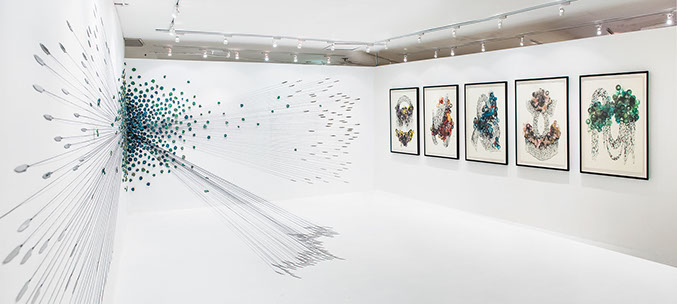Blooms of Hesperides - Tatjana Este
Rubicon Gallery, 13–30 April 2016
The orchard floor: Notes on Blooms of Hesperides by Christopher Hawkes

‘Blooms of Hesperides’ is the third work of the ‘Apple of Discord’ project exploring (in Este’s words) ‘the dichotomy between the beautifully packaged narratives that inform today’s society, and the often unpleasant truth that lies underneath the fabric of our oversaturated, consumerist world’. In all of these works, the apple is the central motif.
The apple is a symbol that appears in various narratives, including the Garden of Eden and Snow White, but in Este’s vision it belongs very much to the golden apple of Greek myths. In his race against Atalanta the huntress, Melanion dropped three golden apples to break her stride and win her hand. At the celebration of the marriage of Peleus, the goddesses in attendance were set against each other by a golden apple marked ‘for the most beautiful’. In his Eleventh Labour, Hercules promised to relieve the titan Atlas of his burden of the sky if he stole a golden apple of immortality from the garden of Hesperides, but then fled his task. In all these stories, the golden apple is representative of distraction, discord and deceit.
In ‘Blooms of Hesperides’ the apples are doubly seductive in their presentation as blooms. In the installation ‘Blueming’, slices of the golden apple have been arranged into a flower pinned to the wall. It is a striking conceit, the cleverness of which draws the viewer closer, only then to realise that the plant’s tendrils are held taut by knives that threaten to entangle and incise. In the series of drawings, ‘Blossoming diversions’, the sliced apple has been used as a stamp to render soft and painterly shapes that appear decorative at first but then strangely suffocating. Bound and circumscribed by snaking lines, the blossoms are also densely overlaid with ink. All are works that both lure and menace.
The simultaneity of this attraction and repulsion is not easily achieved. In continuation of what she sees as a distinctly female tradition of circles, labour and craft are embedded in Este’s art. The drawings are works of many hours of calligraphy with a traditional dip pen in a process that grants little room for correction. For the installations, the apples are bought by the sack, then gilded, sliced, dried and dyed in a race against infestation and decay that also renders them inedible, even poisonous.
And what better symbol of consumerist allure? In the shop windows surrounding this gallery, various tableaus promise comfort, status and glamour, but show nothing of the origins of the products sold. To include the factory, oil well or abattoir would break the spell, as would their probable destiny as landfill. Apples are not food to be eaten and blooms are not beautiful alone. We are lured into the garden and realise too late that it is a corrupt place, abuzz with wasps and sickly with decay. In Este’s world, purchase comes at a price.
– Christopher Hawkes